Morning Glory Flower Detection in Aerial Images Using Semi-Supervised Segmentation with Gaussian Mixture Models
Abstract
1. Introduction
2. Materials and Methods
2.1. Study Site and Ground Truthing
2.2. Unmanned Aircraft System (UAS) and Imaging System
2.3. Machine Learning
2.3.1. Image-Driven Feature Extraction Block
2.3.2. Gaussian Mixture Model (GMM) Initialization
The Expectation-Maximization (EM) Algorithm
2.3.3. Gaussian Clustering and Segmentation
2.3.4. Counting I. purpurea Flowers
| Algorithm 1: I. purpurea Flower Counter |
| Input: Segmented binary flower mask of the high-altitude UAS image. Output: Total number of I. purpurea flowers in the image. Step 1: Initialize Total_Flower_Count = 0; Step 2: Load the flower mask of the high-altitude UAS image; Step 3: Prompt the user to select altitude; Step 4: Determine minimum and maximum pixel count thresholds based on altitude; Step 5: Apply Connected Component Analysis on the binary flower mask; Step 6: for Each connected component in the mask do 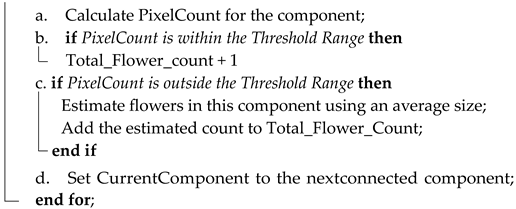 Step 7: Return Total_Flower_Count as the total number of I. purpurea flowers in the image; Step 8: End. |
2.4. Evaluation of the Gaussian Mixture Model (GMM)
3. Results
4. Discussion
5. Conclusions
Author Contributions
Funding
Data Availability Statement
Acknowledgments
Conflicts of Interest
References
- Bhullar, M.S.; Walia, U.; Singh, S.; Singh, M.; Jhala, A.J. Control of morningglories (Ipomoea spp.) in sugarcane (Saccharum spp.). Weed Technol. 2012, 26, 77–82. [Google Scholar] [CrossRef]
- Singh, M.; Ramirez, A.H.; Sharma, S.D.; Jhala, A.J. Factors affecting the germination of tall morningglory (Ipomoea purpurea). Weed Sci. 2012, 60, 64–68. [Google Scholar] [CrossRef]
- Bryson, C.T.; DeFelice, M.S. Weeds of the Midwestern United States and Central Canada; University of Georgia Press: Athens, GA, USA, 2010. [Google Scholar]
- Jones, E.A.; Contreras, D.J.; Everman, W.J. Ipomoea hederacea, Ipomoea lacunosa, and Ipomoea purpurea. In Biology and Management of Problematic Crop Weed Species; Elsevier: Amsterdam, The Netherlands, 2021; pp. 241–259. [Google Scholar]
- Price, A.J.; Williams, J.P.; Duzy, L.A.; McElroy, J.S.; Guertal, E.A.; Li, S. Effects of integrated polyethylene and cover crop mulch, conservation tillage, and herbicide application on weed control, yield, and economic returns in watermelon. Weed Technol. 2018, 32, 623–632. [Google Scholar] [CrossRef]
- Cox, H.R. The Eradication of Bindweed, or Wild Morning-Glory; U.S. Department of Agriculture: Washington, DC, USA, 1909.
- Culpepper, A.S. Glyphosate-induced weed shifts. Weed Technol. 2006, 20, 277–281. [Google Scholar] [CrossRef]
- Webster, T.M.; Nichols, R.L. Changes in the prevalence of weed species in the major agronomic crops of the Southern United States: 1994/1995 to 2008/2009. Weed Sci. 2012, 60, 145–157. [Google Scholar] [CrossRef]
- Wistrom, C.; Purcell, A. The fate of Xylella fastidiosa in vineyard weeds and other alternate hosts in California. Plant Dis. 2005, 89, 994–999. [Google Scholar] [CrossRef] [PubMed]
- Lider, L.; Leonard, O. Morning glory control in vineyards with two new soil-residual herbicides: Dichlobenil and chlorthiamid. Calif. Agric. 1968, 22, 8–10. [Google Scholar]
- Park, Y.-L.; Krell, R.K.; Carroll, M. Theory, technology, and practice of site-specific insect pest management. J. Asia-Pac. Entomol. 2007, 10, 89–101. [Google Scholar] [CrossRef]
- Park, Y.-L.; Krell, R.K. Generation of prescription maps for curative and preventative site-specific management of bean leaf beetles (Coleoptera: Chrysomelidae). J. Asia-Pac. Entomol. 2005, 8, 375–380. [Google Scholar] [CrossRef]
- Hung, C.; Xu, Z.; Sukkarieh, S. Feature learning based approach for weed classification using high resolution aerial images from a digital camera mounted on a UAV. Remote Sens. 2014, 6, 12037–12054. [Google Scholar] [CrossRef]
- Schmale Iii, D.G.; Dingus, B.R.; Reinholtz, C. Development and application of an autonomous unmanned aerial vehicle for precise aerobiological sampling above agricultural fields. J. Field Robot. 2008, 25, 133–147. [Google Scholar] [CrossRef]
- Zhang, C.; Kovacs, J.M. The application of small unmanned aerial systems for precision agriculture: A review. Precis. Agric. 2012, 13, 693–712. [Google Scholar] [CrossRef]
- Garcia-Ruiz, F.; Sankaran, S.; Maja, J.M.; Lee, W.S.; Rasmussen, J.; Ehsani, R. Comparison of two aerial imaging platform for identification of Huanglongbing-infected citrus trees. Comput. Electron. Agric. 2013, 91, 106–115. [Google Scholar] [CrossRef]
- Rajeena, P.F.; Ismail, W.N.; Ali, M.A. A metaheuristic harris hawks optimization algorithm for weed detection using drone images. Appl. Sci. 2023, 13, 7083. [Google Scholar]
- Stephen, S.; Kumar, V. Detection and analysis of weed impact on sugar beet crop using drone imagery. J. Indian Soc. Remote Sens. 2023, 51, 2577–2597. [Google Scholar] [CrossRef]
- Castellano, G.; De Marinis, P.; Vessio, G. Weed mapping in multispectral drone imagery using lightweight vision transformers. Neurocomputing 2023, 562, 126914. [Google Scholar] [CrossRef]
- Xiang, H.; Tian, L. Development of a low-cost agricultural remote sensing system based on an autonomous unmanned aerial vehicle (UAV). Biosyst. Eng. 2011, 108, 174–190. [Google Scholar] [CrossRef]
- Mahony, R.; Kumar, V.; Corke, P. Multirotor aerial vehicles: Modeling, estimation, and control of quadrotor. IEEE Robot. Autom. Mag. 2012, 19, 20–32. [Google Scholar] [CrossRef]
- Rasmussen, J.; Nielsen, J.; Garcia-Ruiz, F.; Christensen, S.; Streibig, J. Potential uses of small unmanned aircraft systems (UAS) in weed research. Weed Res. 2013, 53, 242–248. [Google Scholar] [CrossRef]
- Torres-Sánchez, J.; López-Granados, F.; De Castro, A.I.; Peña-Barragán, J.M. Configuration and specifications of an unmanned aerial vehicle (UAV) for early site specific weed management. PLoS ONE 2013, 8, e58210. [Google Scholar] [CrossRef]
- Hameed, S.; Amin, I. Detection of weed and wheat using image processing. In Proceedings of the 2018 IEEE 5th International Conference on Engineering Technologies and Applied Sciences (ICETAS), Bangkok, Thailand, 22–23 November 2018; pp. 1–5. [Google Scholar]
- Hunter III, J.E.; Gannon, T.W.; Richardson, R.J.; Yelverton, F.H.; Leon, R.G. Integration of remote-weed mapping and an autonomous spraying unmanned aerial vehicle for site-specific weed management. Pest Manag. Sci. 2020, 76, 1386–1392. [Google Scholar] [CrossRef]
- Sapkota, R.; Stenger, J.; Ostlie, M.; Flores, P. Site-specific weed management in corn using UAS imagery analysis and computer vision techniques. arXiv 2022, arXiv:2301.07519. [Google Scholar]
- Shahi, T.B.; Dahal, S.; Sitaula, C.; Neupane, A.; Guo, W. Deep Learning-Based Weed Detection Using UAV Images: A Comparative Study. Drones 2023, 7, 624. [Google Scholar] [CrossRef]
- Trivedi, V.K.; Shukla, P.K.; Dutta, P.K. K-mean and HSV model based segmentation of unhealthy plant leaves and classification using machine learning approach. In Proceedings of the 3rd IET International Smart Cities Symposium, 3SCS-2020, Manama, Bahrain, 21–23 September 2020. [Google Scholar]
- Alomar, K.; Aysel, H.I.; Cai, X. Data augmentation in classification and segmentation: A survey and new strategies. J. Imaging 2023, 9, 46. [Google Scholar] [CrossRef] [PubMed]
- Dempster, A.P.; Laird, N.M.; Rubin, D.B. Maximum likelihood from incomplete data via the EM algorithm. J. R. Stat. Soc. Ser. B 1977, 39, 1–22. [Google Scholar] [CrossRef]
- Leon-Garcia, A. Probability and Random Processes for Electrical Engineering; Pearson Education Inc.: Upper Saddle River, NJ, USA, 2008. [Google Scholar]
- Singh, V.; Rana, A.; Bishop, M.; Filippi, A.M.; Cope, D.; Rajan, N.; Bagavathiannan, M. Unmanned aircraft systems for precision weed detection and management: Prospects and challenges. Adv. Agron. 2020, 159, 93–134. [Google Scholar]
- Mulla, D.J. Twenty five years of remote sensing in precision agriculture: Key advances and remaining knowledge gaps. Biosyst. Eng. 2013, 114, 358–371. [Google Scholar] [CrossRef]
- González-Jorge, H.; Martínez-Sánchez, J.; Bueno, M.; Arias, P. Unmanned aerial systems for civil applications: A review. Drones 2017, 1, 2–19. [Google Scholar] [CrossRef]
- Daponte, P.; De Vito, L.; Glielmo, L.; Iannelli, L.; Liuzza, D.; Picariello, F.; Silano, G. A review on the use of drones for precision agriculture. IOP Conf. Ser. Earth Environ. Sci. 2019, 275, 012022. [Google Scholar] [CrossRef]
- Park, Y.L.; Naharki, K.; Karimzadeh, R.; Seo, B.Y.; Lee, G.S. Rapid assessment of insect pest outbreak using drones: A case study with Spodoptera exigua (Hübner) (Lepidoptera: Noctuidae) in soybean fields. Insects 2023, 14, 555. [Google Scholar] [CrossRef]
- Naharki, K.; Huebner, C.D.; Park, Y.L. The detection of tree of heaven (Ailanthus altissima) using drones and optical sensors: Implications for the management of invasive plants and insects. Drones 2024, 8, 1. [Google Scholar] [CrossRef]
- Park, Y.L.; Gururajan, S.; Thistle, H.; Chandran, R.; Reardon, R. Aerial release of Rhinoncomimus latipes (Coleoptera: Curculionidae) to control Persicaria perfoliata (Polygonaceae) using an unmanned aerial system. Pest Manag. Sci. 2018, 74, 141–148. [Google Scholar] [CrossRef]
- Kim, J.; Huebner, C.D.; Reardon, R.; Park, Y.L. Spatially targeted biological control of mile-a-minute weed using Rhinoncomimus latipes (Coleoptera: Curculionidae) and an unmanned aircraft system. J. Econ. Entomol. 2021, 114, 1889–1895. [Google Scholar] [CrossRef]
- Garre, P.; Harish, A. Autonomous agricultural pesticide spraying uav. IOP Conf. Ser. Mater. Sci. Eng. 2018, 455, 012030. [Google Scholar] [CrossRef]
- Bhattarai, U.; Karkee, M. A weakly-supervised approach for flower/fruit counting in apple orchards. Comput. Ind. 2022, 138, 103635. [Google Scholar] [CrossRef]
- Palacios, F.; Bueno, G.; Salido, J.; Diago, M.P.; Hernández, I.; Tardaguila, J. Automated grapevine flower detection and quantification method based on computer vision and deep learning from on-the-go imaging using a mobile sensing platform under field conditions. Comput. Electron. Agric. 2020, 178, 105796. [Google Scholar] [CrossRef]
- Rahnemoonfar, M.; Sheppard, C. Deep count: Fruit counting based on deep simulated learning. Sensors 2017, 17, 905. [Google Scholar] [CrossRef] [PubMed]
- Dias, P.A.; Tabb, A.; Medeiros, H. Multispecies fruit flower detection using a refined semantic segmentation network. IEEE Robot. Autom. Lett. 2018, 3, 3003–3010. [Google Scholar] [CrossRef]
- Zhao, P.; Shin, B.C. Counting of flowers based on k-means clustering and watershed segmentation. J. Korean Soc. Ind. Appl. Math. 2023, 27, 146–159. [Google Scholar]
- Proïa, F.; Pernet, A.; Thouroude, T.; Michel, G.; Clotault, J. On the characterization of flowering curves using Gaussian mixture models. J. Theor. Biol. 2016, 402, 75–88. [Google Scholar] [CrossRef] [PubMed]
- MMSegmentation. Openmmlab Semantic Segmentation Toolbox and Benchmark. Available online: https://github.com/open-mmlab/mmsegmentation (accessed on 11 February 2024).
- Li, J.; Wang, E.; Qiao, J.; Li, Y.; Li, L.; Yao, J.; Liao, G. Automatic rape flower cluster counting method based on low-cost labelling and UAV-RGB images. Plant Methods 2023, 19, 40. [Google Scholar] [CrossRef] [PubMed]
- Guo, Z.; Yao, J.; Jiang, Y.; Zhu, X.; Tan, Z.; Wen, W. A novel distributed unit transient protection algorithm using support vector machines. Electr. Power Syst. Res. 2015, 123, 13–20. [Google Scholar] [CrossRef]
- Huang, Y.; Reddy, K.N.; Fletcher, R.S.; Pennington, D. UAV low-altitude remote sensing for precision weed management. Weed Technol. 2018, 32, 2–6. [Google Scholar] [CrossRef]
- You, Z.; Yang, K.; Luo, W.; Lu, X.; Cui, L.; Le, X. Few-shot object counting with similarity-aware feature enhancement. In Proceedings of the IEEE/CVF Winter Conference on Applications of Computer Vision, Waikoloa, HI, USA, 3–7 January 2023; pp. 6315–6324. [Google Scholar]
- Xu, J.; Le, H.; Nguyen, V.; Ranjan, V.; Samaras, D. Zero-Shot Object Counting. In Proceedings of the IEEE/CVF Conference on Computer Vision and Pattern Recognition, Vancouver, BC, Canada, 17–24 June 2023; pp. 15548–15557. [Google Scholar]
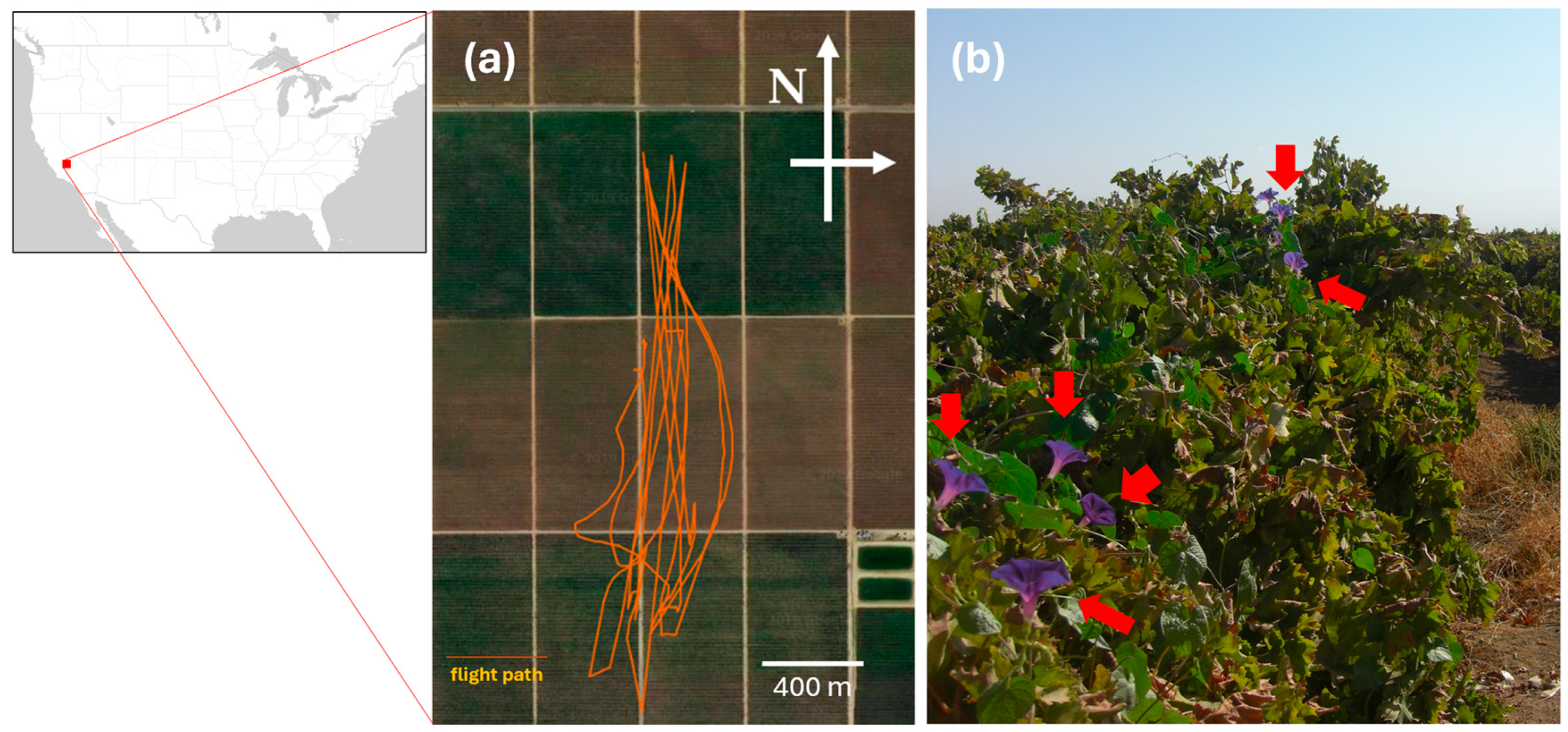

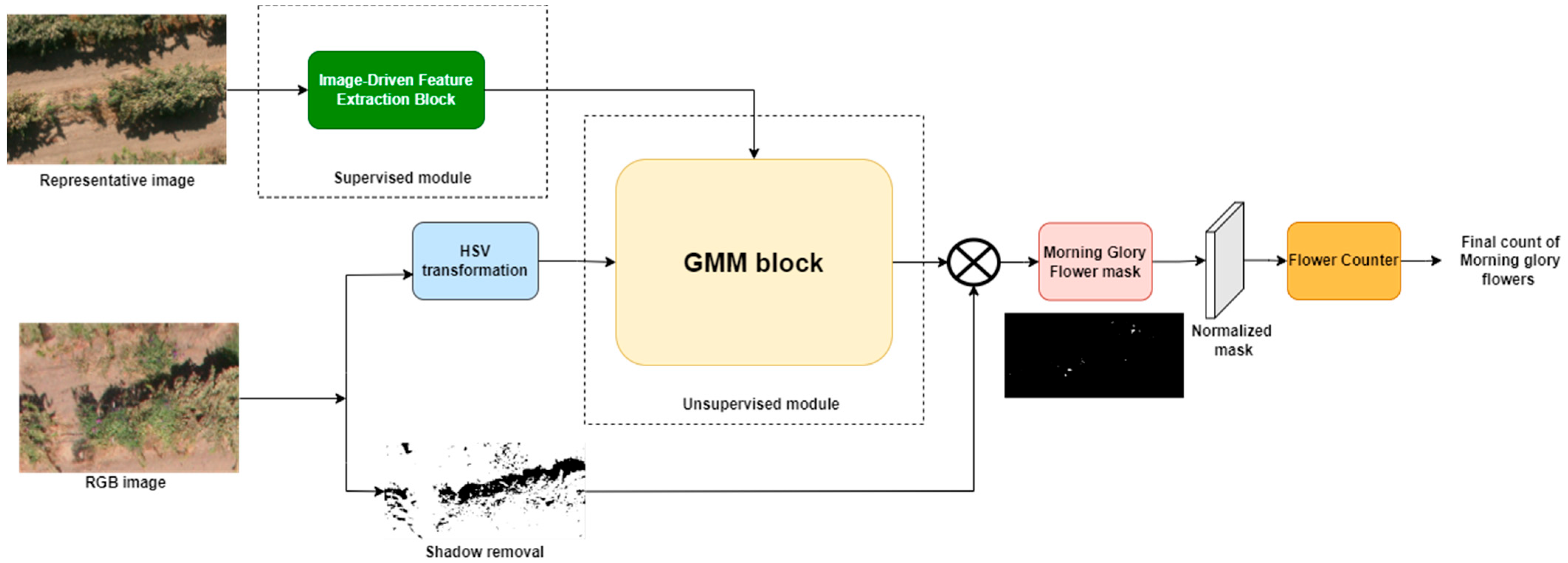


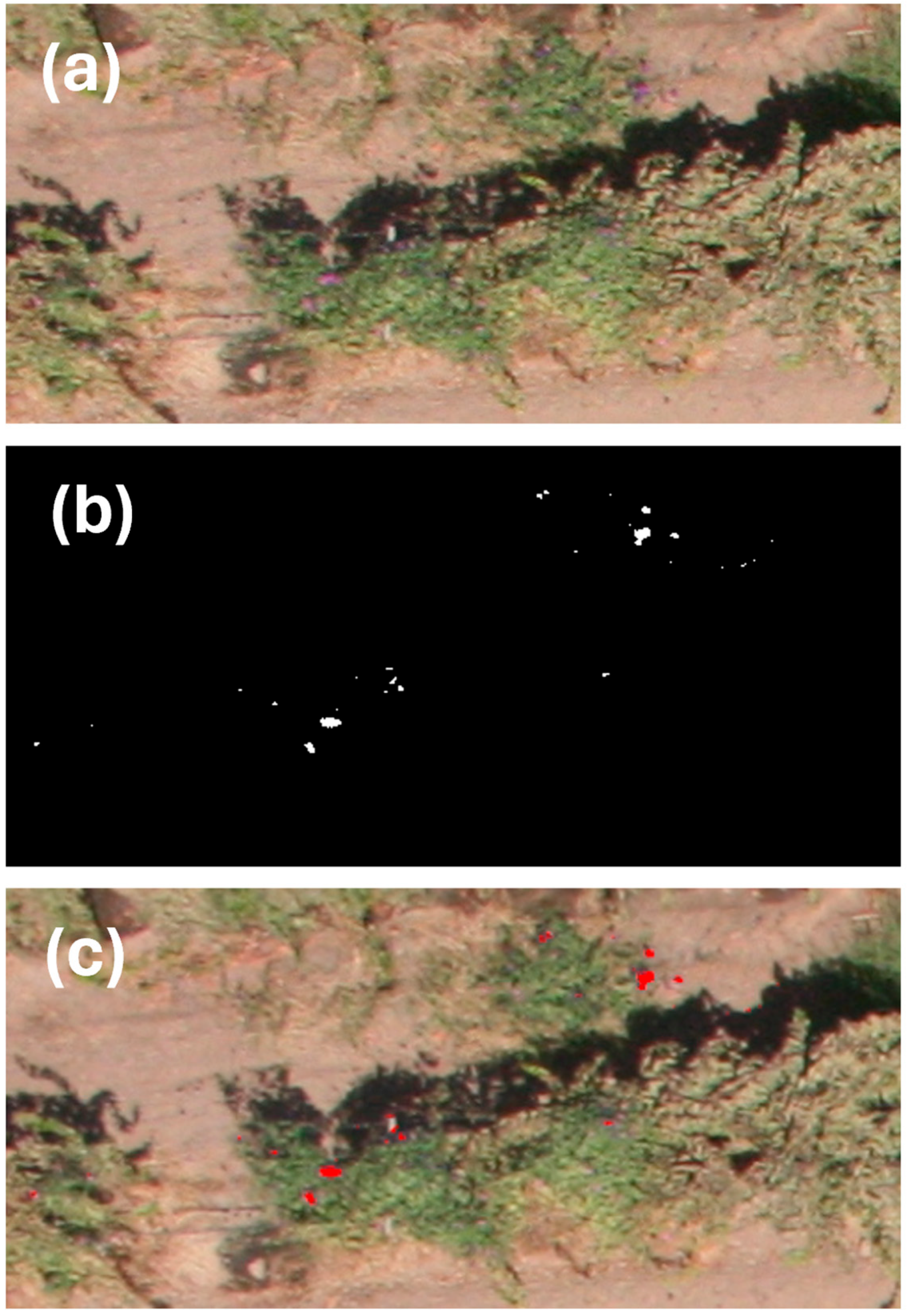
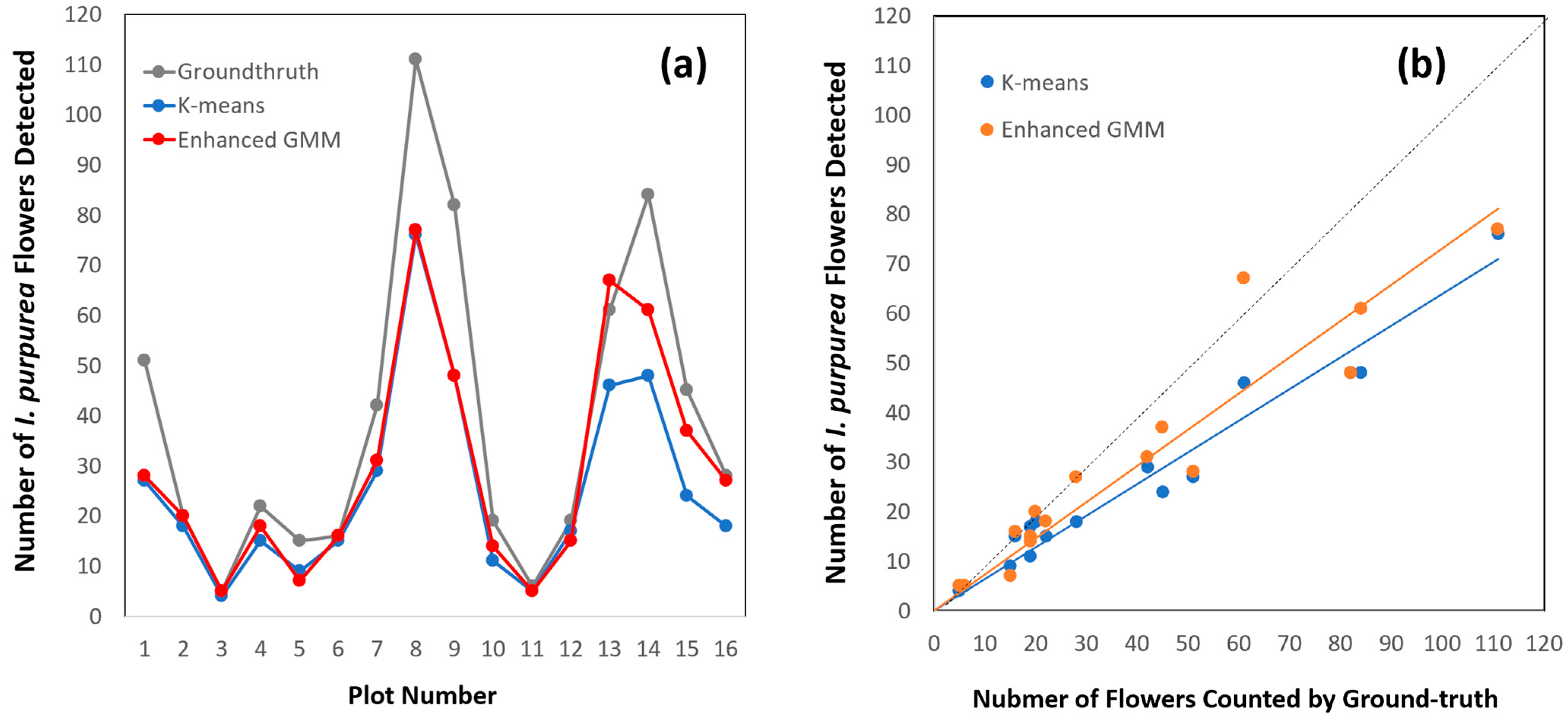
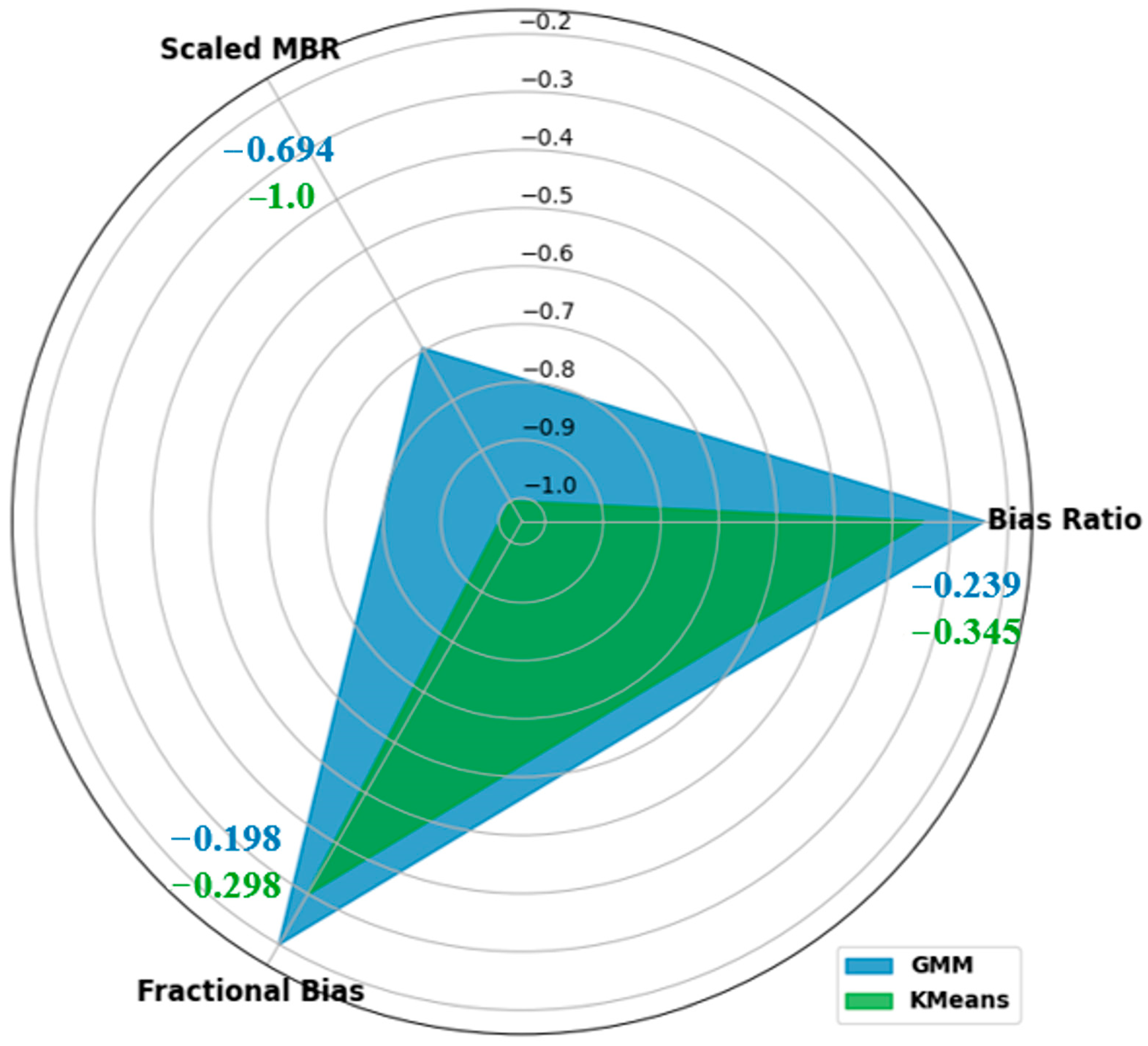
| Aircraft Parameters | Values |
|---|---|
| Wing span | 1.68 m |
| Root chord | 0.483 m |
| Tip chord | 0.203 m |
| Weight | 4.58 kg |
| Takeoff weight with payload | ~6.12 kg |
| Average cruise airspeed | 13.3 m/s |
| Turning radius | 5.03 m |
| Payload capacity | ~1.36 kg |
| Fuselage length | 1.80 m |
| Engine type | GMS 0.76 2-Stroke Glow Engine |
| Engine horsepower | 1.9 |
| Propeller | Two blades (12 inches by 6 inches) |
| RPM range | 2000–13,000 |
| Flight duration | ~10 min |
| Fuel type | Glow fuel at 15% Nitro |
| Fuel tank capacity | 16 oz. |
| Item or Setting | Specification |
|---|---|
| Camera type | Digital AF/AE SLR with built-in flash |
| Recording media | CompactFlash (CF) Card Types I and II |
| Image format | 22.2 × 14.8 mm (APS-C-size sensor) |
| Pixels | Approx. 10.10 megapixels |
| Aspect ratio | 3:2 (horizontal:vertical) |
| Color filter system | RGB primary color filters |
| Low-pass filter | Fixed position in front of the CMOS sensor |
| Image format | JPEG, RAW (Canon .CR2) |
| Auto white balance | Auto white balance with the image sensor |
| Color temperature compensation | White balance bracketing: +/− stops in 1-stop increments. White balance correction: blue/amber bias +/− 9 levels, magenta/green bias ± 9 levels |
| Autofocus | TTL-CT-SIR with a CMOS sensor, 9 AF points, EV −0.5–18 (ISO 100 at 23 °C) |
| Shutter speeds | Speed of 1/4000 to 30 s. (1/3- and 1/2-stop increments), X-sync at 1/200 s. |
| Remote control | Remote control with Remote Switch RS-60E3 or Wireless Remote Controllers RC-1/RC-5 |
| Drive modes | Single, continuous, self-timer/remote control |
| Continuous shooting speed | Approx. 3 fps (at a shutter speed of 1/250 s or faster) |
| Maximum burst | JPEG: ca. 27 frames (Large/Fine) |
| Dimensions (W × H × D) | 126.5 × 94.2 × 65 mm |
| Weight | 510 g (body only) |
| Lens: angle of view | For EF-S, 18–55 mm f/3.5–5.6 II; diagonal extent: 74°20′–27°50′; horizontal extent: 64°30′–23°20′; vertical extent: 45°30′–15°40′ |
| Minimum aperture | f/22–36 |
| Closest focusing distance | Distance of 0.28 m from the image sensor plane |
| Plot | Number of I. purpurea Flowers Detected | ||
|---|---|---|---|
| Ground-Truth | K-Means | Enhanced GMM | |
| 1 | 51 | 27 | 28 |
| 2 | 20 | 18 | 20 |
| 3 | 5 | 4 | 5 |
| 4 | 22 | 15 | 18 |
| 5 | 15 | 9 | 7 |
| 6 | 16 | 15 | 16 |
| 7 | 42 | 29 | 31 |
| 8 | 111 | 76 | 77 |
| 9 | 82 | 48 | 48 |
| 10 | 19 | 11 | 14 |
| 11 | 6 | 5 | 5 |
| 12 | 19 | 17 | 15 |
| 13 | 61 | 46 | 67 |
| 14 | 84 | 48 | 61 |
| 15 | 45 | 24 | 37 |
| 16 | 28 | 18 | 27 |
| Image Analysis Method | RMSE | MAE | Max Error |
|---|---|---|---|
| K-means clustering | 17.73 | 12.7 | 36 |
| Our GMM | 14.78 | 9.52 | 34 |
Disclaimer/Publisher’s Note: The statements, opinions and data contained in all publications are solely those of the individual author(s) and contributor(s) and not of MDPI and/or the editor(s). MDPI and/or the editor(s) disclaim responsibility for any injury to people or property resulting from any ideas, methods, instructions or products referred to in the content. |
© 2024 by the authors. Licensee MDPI, Basel, Switzerland. This article is an open access article distributed under the terms and conditions of the Creative Commons Attribution (CC BY) license (https://creativecommons.org/licenses/by/4.0/).
Share and Cite
Valicharla, S.K.; Wang, J.; Li, X.; Gururajan, S.; Karimzadeh, R.; Park, Y.-L. Morning Glory Flower Detection in Aerial Images Using Semi-Supervised Segmentation with Gaussian Mixture Models. AgriEngineering 2024, 6, 555-573. https://doi.org/10.3390/agriengineering6010034
Valicharla SK, Wang J, Li X, Gururajan S, Karimzadeh R, Park Y-L. Morning Glory Flower Detection in Aerial Images Using Semi-Supervised Segmentation with Gaussian Mixture Models. AgriEngineering. 2024; 6(1):555-573. https://doi.org/10.3390/agriengineering6010034
Chicago/Turabian StyleValicharla, Sruthi Keerthi, Jinge Wang, Xin Li, Srikanth Gururajan, Roghaiyeh Karimzadeh, and Yong-Lak Park. 2024. "Morning Glory Flower Detection in Aerial Images Using Semi-Supervised Segmentation with Gaussian Mixture Models" AgriEngineering 6, no. 1: 555-573. https://doi.org/10.3390/agriengineering6010034
APA StyleValicharla, S. K., Wang, J., Li, X., Gururajan, S., Karimzadeh, R., & Park, Y.-L. (2024). Morning Glory Flower Detection in Aerial Images Using Semi-Supervised Segmentation with Gaussian Mixture Models. AgriEngineering, 6(1), 555-573. https://doi.org/10.3390/agriengineering6010034









